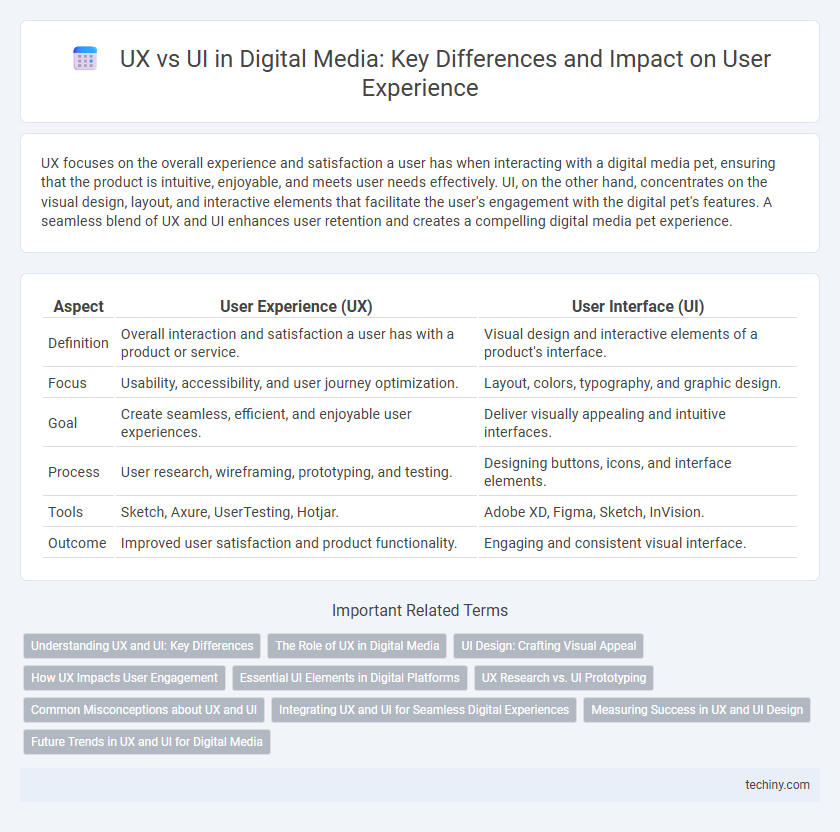UX focuses on the overall experience and satisfaction a user has when interacting with a digital media pet, ensuring that the product is intuitive, enjoyable, and meets user needs effectively. UI, on the other hand, concentrates on the visual design, layout, and interactive elements that facilitate the user's engagement with the digital pet's features. A seamless blend of UX and UI enhances user retention and creates a compelling digital media pet experience.
Table of Comparison
| Aspect | User Experience (UX) | User Interface (UI) |
|---|---|---|
| Definition | Overall interaction and satisfaction a user has with a product or service. | Visual design and interactive elements of a product's interface. |
| Focus | Usability, accessibility, and user journey optimization. | Layout, colors, typography, and graphic design. |
| Goal | Create seamless, efficient, and enjoyable user experiences. | Deliver visually appealing and intuitive interfaces. |
| Process | User research, wireframing, prototyping, and testing. | Designing buttons, icons, and interface elements. |
| Tools | Sketch, Axure, UserTesting, Hotjar. | Adobe XD, Figma, Sketch, InVision. |
| Outcome | Improved user satisfaction and product functionality. | Engaging and consistent visual interface. |
Understanding UX and UI: Key Differences
User Experience (UX) focuses on the overall journey and satisfaction a user has with a digital product, emphasizing usability, accessibility, and interaction flow. User Interface (UI) concentrates on the visual elements and interactive components, including layout, color schemes, and typography that create the product's look and feel. Understanding the key differences between UX and UI helps in designing digital media that is both functional and aesthetically appealing, driving user engagement and retention.
The Role of UX in Digital Media
User Experience (UX) plays a critical role in digital media by shaping how audiences interact with content across platforms, ensuring seamless navigation and emotional engagement. Effective UX design optimizes usability, accessibility, and functionality, directly influencing viewer retention and satisfaction. Prioritizing user-centric research and testing leads to intuitive interfaces that enhance digital media consumption and brand loyalty.
UI Design: Crafting Visual Appeal
UI Design focuses on crafting visually appealing interfaces through the strategic use of color, typography, and layout to enhance user interaction. It plays a critical role in creating intuitive navigation and consistent branding, which boosts user engagement and satisfaction. Effective UI design integrates aesthetic principles with functionality to deliver a seamless digital experience.
How UX Impacts User Engagement
User Experience (UX) significantly influences user engagement by optimizing the functionality, accessibility, and overall satisfaction of digital platforms. Intuitive navigation, fast load times, and personalized interactions enhance user retention and encourage repeat visits. Data-driven UX improvements directly correlate with increased session duration and higher conversion rates, demonstrating the critical role of UX in digital media success.
Essential UI Elements in Digital Platforms
Essential UI elements in digital platforms include buttons, icons, navigation menus, and input fields, all designed to facilitate user interaction. UX focuses on the overall user journey and satisfaction, while UI emphasizes the look, feel, and responsiveness of these visual components. Seamlessly integrated UI elements enhance usability and accessibility, driving higher engagement and retention rates.
UX Research vs. UI Prototyping
UX research focuses on understanding user behaviors, needs, and motivations through techniques like interviews, surveys, and usability testing to inform product design. UI prototyping involves creating interactive visual models of the interface to test and refine layout, navigation, and design elements before development. Integrating UX research insights with detailed UI prototypes enhances user satisfaction and reduces costly redesigns in digital media projects.
Common Misconceptions about UX and UI
UX and UI are often confused, but UX focuses on the overall user journey and satisfaction, while UI deals with the visual and interactive elements of a product. A common misconception is that UI is just about aesthetics, neglecting its role in usability and functionality. Many believe UX design only involves usability testing, overlooking research, information architecture, and user psychology as critical components.
Integrating UX and UI for Seamless Digital Experiences
Integrating UX and UI is crucial for creating seamless digital experiences that prioritize user satisfaction and engagement. UX design focuses on optimizing the overall user journey by enhancing functionality and accessibility, while UI design emphasizes visual aesthetics and interactive elements to foster intuitive navigation. Combining these disciplines ensures a cohesive interface where usability meets appealing design, driving higher retention and conversion rates in digital media platforms.
Measuring Success in UX and UI Design
Measuring success in UX design involves analyzing user engagement metrics, task completion rates, and customer satisfaction scores to ensure intuitive and efficient interaction. UI design success is evaluated through visual consistency, responsiveness, and the effectiveness of design elements in guiding user behavior. Both UX and UI metrics combined provide comprehensive insights into digital media performance and user experience optimization.
Future Trends in UX and UI for Digital Media
Future trends in UX and UI for digital media emphasize the integration of AI-driven personalization, voice user interfaces, and immersive experiences through AR and VR technologies. Designers are prioritizing adaptive layouts and seamless interactions that respond to user context and behavior in real-time. This evolution enhances accessibility and engagement, creating more intuitive and dynamic digital environments.
UX vs UI Infographic

 techiny.com
techiny.com